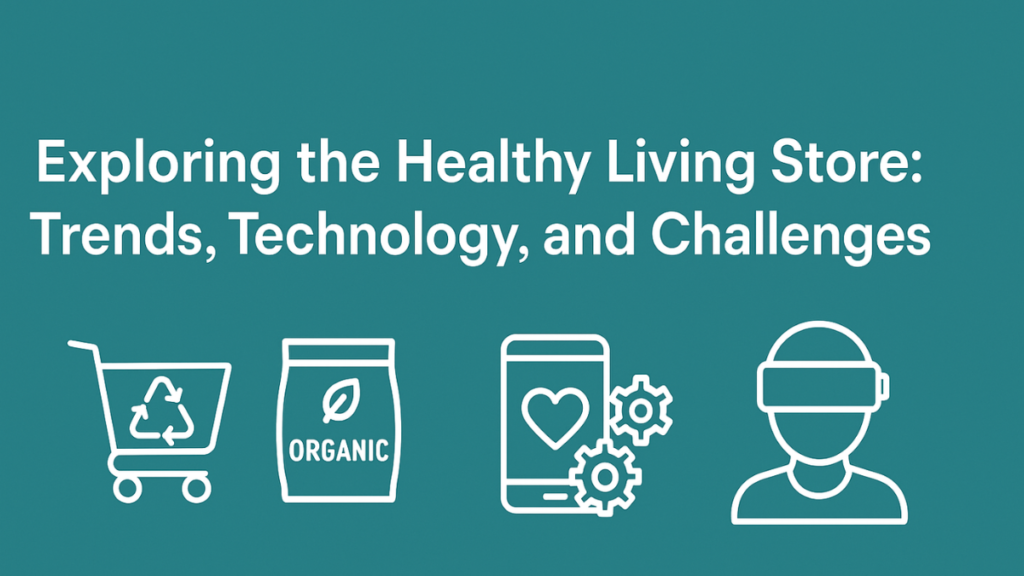Dive deep into the evolution of the healthy living store—discover emerging trends, cutting-edge technology, and key challenges in the wellness retail sector today.
also read: https://babessproduct.com/how-effective-is-prp-for-thinning-hair/
Introduction
In today’s wellness-driven world, the concept of the Healthy Living Store has evolved far beyond traditional health food outlets. These modern retail spaces now serve as one-stop hubs for everything from organic produce and supplements to wearable tech and eco-conscious lifestyle products. As consumer awareness about health, sustainability, and holistic living grows, so too does the demand for innovative products and seamless shopping experiences.
In this article, we’ll be exploring the Healthy Living Store: trends, technology, and challenges shaping the landscape. You’ll learn how these stores are adapting to meet modern demands, the role of digital innovation, and the roadblocks retailers face on the path to holistic retail excellence.
What Is a Healthy Living Store?
A Healthy Living Store refers to a retail space—either brick-and-mortar or digital—focused on products that promote health, wellness, and sustainability. These include:

- Nutritional supplements and vitamins
- Organic and locally sourced groceries
- Eco-friendly personal care items
- Natural household products
- Fitness and wellness tech
Whether it’s a sleek urban wellness market or an expansive e-commerce platform, the purpose remains the same: help customers lead healthier, more balanced lives through informed choices.
Key Trends Reshaping Healthy Living Stores
1. Personalization in Product Selection
Consumers no longer want a one-size-fits-all solution. Instead, they seek products tailored to their unique needs, body types, and lifestyles. Healthy living stores are responding by offering:
- DNA-based nutrition kits
- Customized supplement packs
- Personalized skincare routines
This shift is driven by data and innovation, giving customers a sense of empowerment in their wellness journey.
2. Rise of Plant-Based and Functional Foods
Demand for plant-based products continues to soar. Whether due to ethical reasons, dietary choices, or environmental concerns, plant-based and functional foods—those offering added health benefits—are taking over shelves.

Examples include:
- Adaptogenic teas
- Protein-rich meat alternatives
- Gut-friendly fermented snacks
Healthy living stores are stocking up on these products to attract the health-conscious millennial and Gen Z shoppers.
3. Sustainability as a Core Value
Consumers are increasingly choosing brands and stores that align with their environmental values. This has led to several sustainability-focused trends:
- Plastic-free packaging
- Locally sourced inventory
- Low-waste refill stations
- Renewable energy usage in physical stores
Sustainability is no longer an option—it’s a brand essential in today’s wellness economy.
Role of Technology in Healthy Living Stores

Smart Inventory and Supply Chain Management
With the help of AI and machine learning, stores are now:
- Predicting demand patterns
- Reducing waste by managing perishable goods more effectively
- Sourcing ethical products through blockchain tracking
This not only boosts efficiency but also improves transparency, a factor consumers care deeply about.
Virtual and Augmented Reality Shopping
Online healthy living stores are incorporating AR and VR to improve customer experience. For example:
- Virtual “try-before-you-buy” for supplements and skincare
- 3D store navigation for remote wellness shoppers
- Interactive ingredient education via augmented product displays
This tech is especially valuable in e-commerce environments, helping bridge the sensory gap of online shopping.
Mobile Apps for a Seamless Wellness Experience
Apps allow users to scan products, track health goals, and get personalized recommendations based on past purchases or wearable data. These digital companions integrate shopping, health tracking, and goal setting—all in one place.
Major Challenges Facing Healthy Living Stores
Consumer Education and Misinformation
Despite rising interest, many consumers are still confused about what products they actually need. Buzzwords like “natural” or “clean” often lack regulation, leading to misinformation and distrust. Stores must now invest in:
- Clear labeling
- In-store experts or nutritionists
- Trustworthy content and guides
Educating customers is as important as selling to them.
Balancing Price with Accessibility
Many healthy products come at a premium. While affluent consumers may absorb the cost, others are left out. Healthy living stores must walk the line between profit and inclusivity. Solutions include:
- Private-label alternatives
- Tiered pricing
- Discount programs for recurring buyers
Making wellness affordable is crucial for long-term customer loyalty.
Regulatory Compliance and Product Authenticity
With increased scrutiny from health authorities, stores must maintain compliance with labeling laws, ingredient transparency, and sourcing ethics. Authenticity in the healthy living industry is not just moral—it’s legal.
Table: Comparison of Traditional Stores vs. Modern Healthy Living Stores
| Feature | Traditional Health Store | Modern Healthy Living Store |
|---|---|---|
| Product Range | Limited to food & vitamins | Food, tech, personal care, wearables |
| Technology Integration | Minimal | AI, AR, apps, virtual assistants |
| Sustainability Focus | Low | High—eco-packaging, local sourcing |
| Personalization | Generic products | DNA-based, tailored supplements |
| Customer Education Tools | In-store brochures | Blogs, AI chatbots, virtual experts |
Future Outlook: Where Are Healthy Living Stores Headed?
The future of healthy living stores lies in hyper-personalized wellness ecosystems. With wearables becoming more mainstream, data-driven product recommendations will soon dominate. Picture this: your smartwatch flags low energy, and your app suggests a natural supplement available at your favorite store—ready for same-day delivery.
Additionally, physical store design will evolve into wellness experiences, complete with meditation zones, juice bars, and virtual health coaches. The line between retail and wellness service is blurring—and that’s a good thing for consumers.
FAQs
- What is the difference between a health store and a healthy living store?
A health store focuses mainly on supplements and basic health items, while a healthy living store offers a holistic range including food, wellness tech, eco-products, and personal care. - Do healthy living stores sell products for children and pets?
Yes, many stores now include organic and eco-friendly options for children and pets, from food to hygiene products. - Can I shop at a healthy living store online?
Absolutely! Many healthy living stores have robust e-commerce platforms offering delivery and personalized recommendations. - How can I verify the quality of products in a healthy living store?
Look for certifications like USDA Organic, Non-GMO, and third-party testing on supplement labels. - Are there healthy living stores that offer subscription services?
Yes, many stores provide subscription boxes for vitamins, snacks, and even eco-friendly household goods. - Is everything in a healthy living store always organic?
Not necessarily. While many items are organic, some may focus more on sustainability, ethical sourcing, or functional benefits. - How do these stores ensure sustainability in sourcing?
Through partnerships with local farms, fair-trade suppliers, and blockchain tracking for supply chain transparency. - Do healthy living stores cater to specific dietary needs like keto or gluten-free?
Yes, most offer clearly labeled sections for specific diets including vegan, keto, paleo, and gluten-free. - Can wearable tech purchased from these stores sync with fitness apps?
Most wellness tech offered is compatible with major fitness apps like Apple Health, Fitbit, and Google Fit. - Are there loyalty programs or rewards for shopping at these stores?
Many healthy living stores offer rewards points, member discounts, and exclusive early access to new products.
Conclusion
Exploring the Healthy Living Store: Trends, Technology, and Challenges reveals an exciting, transformative space at the intersection of wellness, retail, and innovation. From AI-driven personalization and sustainability efforts to overcoming barriers like misinformation and pricing, these stores are changing how we engage with health.
As the demand for conscious, holistic living continues to grow, healthy living stores are uniquely positioned to not just meet—but exceed—modern wellness expectations. Whether you’re a tech-savvy shopper or someone taking the first step toward better health, these stores are becoming essential allies in your wellness journey.
also read: https://babessproduct.com/how-telehealth-is-revolutionizing-rural-healthcare-access/
also read: https://babessproduct.com/the-benefits-of-personalized-care-plans-in-home-health-care/

